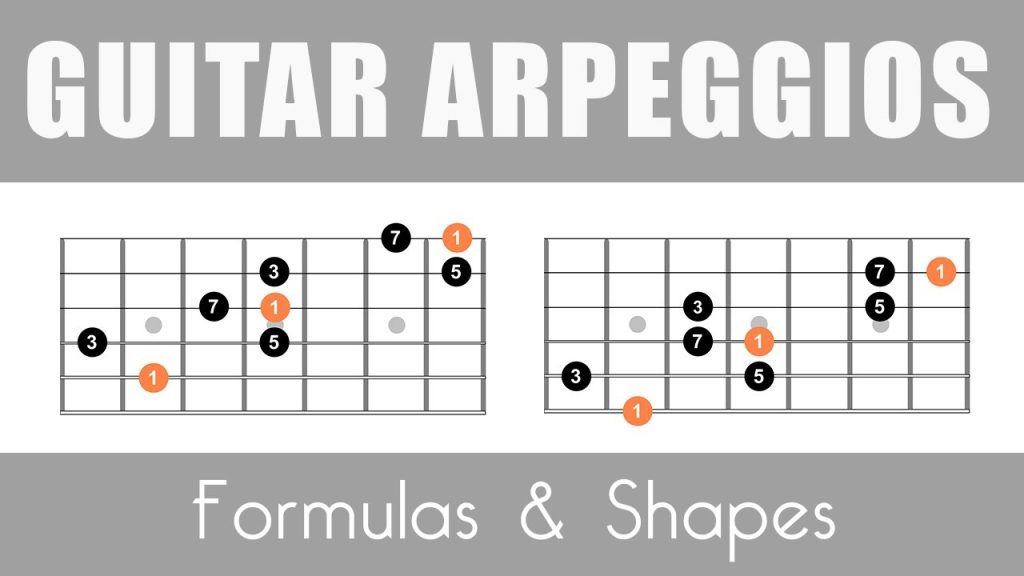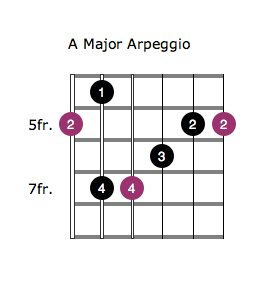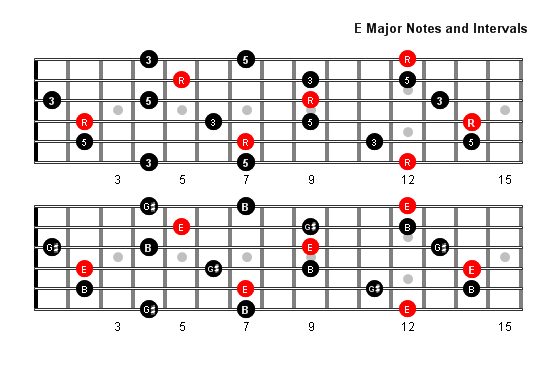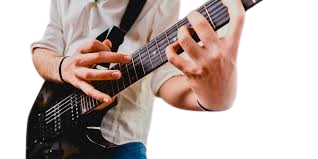Guitar Arpeggios Exercises – Master the fretboard with guitar arpeggio exercises! Learn essential shapes, alternate picking, & build finger speed.
Table of Contents

Hi. Ian here and welcome to this article!
Ever heard a song with that smooth, shimmering guitar part that just washes over you? Chances are, that beauty was built on something called arpeggios.
Don’t worry, it sounds way more complicated than it is. Arpeggios are just fancy chords played note by note, and mastering them is your key to unlocking a world of awesome-sounding guitar techniques.
Think of a power chord – the kind that makes classic rock roar. Now, instead of strumming all the strings at once, try picking each note individually. That, my friend, is an arpeggio! It might sound simple, but trust me, these little exercises will have your fingers flying and your guitar vocabulary expanding faster than you can say “shred solo.”
The benefits of incorporating “Guitar Arpeggio Exercises” into your practice routine are endless. First off, they’ll strengthen your finger independence – no more sloppy chords where one finger overpowers the others. Plus, arpeggios train your ear to recognize intervals within chords, making it easier to improvise and write your own music. Need proof? Joe Satriani, Steve Vai, and countless other guitar legends all credit arpeggios for their jaw-dropping skills [sources about guitarists using arpeggios can be found online].
So, are you ready to take your guitar playing to the next level? Get comfy, grab your axe, and let’s dive into some killer “Guitar Arpeggio Exercises” that will have you sounding like a pro in no time!
Getting Started with Guitar Arpeggios
When you embark on the journey of mastering guitar arpeggios, your focus should be on understanding their structure and learning the fundamental shapes and patterns. This foundation will enhance your technique and knowledge of the fretboard, facilitating more effective practice sessions.
Understanding Guitar Arpeggios
Arpeggios are the notes of a chord played in succession, either ascending or descending. Unlike strummed chords, where the notes are played simultaneously, arpeggios highlight each individual note, allowing for a melodic contour within the harmony. To get started, familiarise yourself with the concept of arpeggiation, and pay attention to how arpeggios can traverse the fretboard, connecting various chord shapes and inversions.
Basic Arpeggio Shapes and Patterns
To begin your practice, you’ll need to learn some basic arpeggio shapes and patterns:
- Major Triad: Root (1), Major third (3), Perfect fifth (5)
- Minor Triad: Root (1), Minor third (b3), Perfect fifth (5)
Here’s a simple table to visualize these triads on the fretboard:
| Triad Type | Pattern Layout |
|---|---|
| Major | 1 – 3 – 5 |
| Minor | 1 – b3 – 5 |
Begin by playing these patterns starting from the root note on the low E string and move your way across the different strings. Be mindful of your technique; use alternate picking to ensure efficiency and control as you navigate across the strings. Incorporate these shapes into your practice routine, moving them around the fretboard to play arpeggios in different keys. This approach will solidify your understanding of arpeggio construction and prepare you for more complex patterns.
Mastering Major and Minor Arpeggios

Mastering arpeggios on the guitar is essential for adding depth to your playing and fully understanding the fretboard. This section will guide you through exercises for major and minor arpeggios, which are the building blocks of many musical styles.
Major Arpeggios Exercises
To begin with, major arpeggios, start by playing the C major arpeggio across the fretboard. Commence with the root note on the third fret of the A string, following the major scale pattern.
- C Major Open Position:
- C (3rd fret, A string)
- E (2nd fret, D string)
- G (Open, G string)
After you’re comfortable in the open position, practice playing the C major arpeggio in different positions and octaves across the neck. Here’s an exercise:
- Play the arpeggio ascending and descending, starting slow and increasing speed gradually.
- Shift the pattern to different root notes to play major arpeggios in other keys.
For structured exercises, you can use guitar arpeggio exercises to expand your repertoire and unlock the fretboard.
Minor Arpeggios Exercises
Switching to minor arpeggios, the D minor and E minor are great starting points. For example, the D minor arpeggio can be found by beginning on the open D string:
- D Minor Open Position:
- D (Open, D string)
- F (1st fret, E string)
- A (2nd fret, G string)
After mastering the open position, try the E minor arpeggio starting on the seventh fret of the A string:
- E (7th fret, A string)
- G (5th fret, D string)
- B (4th fret, G string)
Incrementally increase the complexity by practicing minor 7 arpeggios:
- Em7: Combine the E minor triad with the minor 7th note (D).
Utilise the exercises mentioned on Jazz Guitar Licks.com to elevate your understanding and application of minor arpeggios within different musical contexts.
Advancing Your Technique
To elevate your guitar playing, focusing on refining your technique is essential. Let’s explore methods to enhance alternate picking proficiency and the use of intervals and triads in your arpeggio practice.
Alternate Picking for Arpeggios
Alternate picking is a fundamental skill that brings finesse and speed to your arpeggio execution. Begin with a down-up picking pattern, ensuring each note is articulated cleanly. Practice with arpeggios in triplets to develop a rhythmic feel and pick-hand dexterity. Here’s a basic example to get started:
- C Major Arpeggio: C-E-G
- Picking Pattern: Down, Up, Down (repeat in reverse)
| String | Note | Picking Direction |
|---|---|---|
| 5th | C | Down |
| 4th | E | Up |
| 3rd | G | Down |
| 4th | E | Up |
| 5th | C | Down |
Incorporating Intervals and Triads
Incorporating intervals and triads into your arpeggio practice will expand your understanding of the fretboard. Start by identifying the root, third, and fifth intervals of a chord to form a triad. Practice these triads across various strings and positions to internalise the sounds and shapes. For a practical exercise, use the teachings from 10 Guitar Arpeggio Exercises as a foundation to explore diatonic arpeggios and achieve a more melodic aspect in your playing. Remember the order of triads within a key:
- Major: Root – major Third – perfect Fifth
- Minor: Root – minor Third – perfect Fifth
Spend time mastering each concept separately before weaving them together for a more comprehensive approach. Your dedication to these exercises will bring a notable improvement to your overall technique and musicality.
Arpeggios Across the Fretboard
Mastering arpeggios across the fretboard involves two key concepts: connecting arpeggio positions and visualizing chords within arpeggio patterns. This will significantly enhance your ability to navigate the fretboard and translate chords into fluid lead lines.

Connecting Arpeggio Positions
To fluidly connect arpeggio positions, you’ll need to practice moving between different shapes on the fretboard. For instance, shifting from an E major shape to an A minor shape involves more than a mere finger slide; it requires an understanding of the underlying notes and intervals. Start from the root note of a major triad and proceed to play each corresponding note across various strings and frets, maintaining the integrity of the arpeggio’s structure.
- E Major Shape:
- Start on the low E string and play the root (E), third (G#), and fifth (B).
- Shift to the next octaves of E major up the fretboard.
- A Minor 7 Shape:
- Begin on the A string, hitting the root (A), minor third (C), fifth (E), and minor 7th (G).
- Move this pattern to different root notes across the fretboard.
Visualising Chords as Arpeggio Patterns
Viewing chords as patterns of arpeggios can revolutionise your soloing and improvisation skills. Instead of merely strumming chords, identify each note within the chord and play them individually to form arpeggios. By practicing this method, a simple C major chord can be seen as a C major arpeggio, and playing through these notes sequentially will help visualize and navigate the fretboard more effectively.
- C Major Chord Translation:
- Identify the root (C), third (E), and fifth (G) from the chord shape.
- Play these notes across the fretboard to form a C major arpeggio pattern.
In transforming chord shapes into arpeggio patterns, you develop a deeper understanding of the fretboard’s vast landscape and unlock the potential for creative expression.
Practical Applications of Arpeggios
Arpeggios provide a foundation for creating melodious solos and intricate parts that define many guitar-led pieces. By understanding their applications, you can enhance your musical expression and technical skills on the guitar.
Using Arpeggios in Musical Context
When you incorporate arpeggios into your playing, you’re essentially outlining the chords in a song through individual notes. This approach to playing can add depth to your rhythm and lead parts, particularly through the use of major 7, minor 7, and dominant arpeggio patterns.
For rhythm guitarists, the application of arpeggios can be subtle yet effective. Start by breaking down chords into their individual notes and play them in sequence to match the rhythm of the song. Consider the context of the music – a gentle ballad might benefit from sparse, picked arpeggios, whereas a funk tune might require tight, staccato movements to fit the groove.
Arpeggio-Based Licks and Riffs
Arpeggios aren’t just for accentuating rhythm; they are also highly useful for crafting memorable licks and riffs. As a guitarist, you can build these melodic ideas by focusing on the key arpeggio patterns within the relevant scale. A lick using a minor 7 arpeggio can sound haunting and moody, while a riff based on a dominant arpeggio pattern can inject a sense of tension and release, perfect for blues or jazz progression.
Here’s an example of how you might structure a guitar lick using arpeggios:
- Identify the chord progression of the song.
- Choose arpeggio patterns that correspond to each chord.
- Create a sequence of notes that rhythmically fits into a bar or phrase.
- Integrate string skipping, hammer-ons, or pull-offs for added complexity.
Guitarists can spice up their solos and provide a melody line that is both recognisable and harmonically correct by skillfully weaving arpeggios with other elements of music theory. With practice, your ability to use arpeggios will open up a more articulate and dynamic range of playing.
Exploring Advanced Arpeggio Concepts
As you delve deeper into guitar arpeggios, mastering advanced concepts such as jazz harmony and modal applications is crucial for elevating your improvisational skills and understanding.
Jazz Harmony and Arpeggio Techniques
In jazz harmony, arpeggios are integral for crafting complex chord progressions and solos. By incorporating bebop scales and altered jazz guitar lines, you can enhance your jazz vocabulary. Utilise arpeggios over jazz standards to outline the harmony while adding chromatic tones for a more authentic bebop feel. Practice arpeggios that connect with walking bass lines, ensuring each chord tone is hit on the strong beats to maintain the groove of the piece.
Modal Arpeggios and Their Uses
Modal arpeggios provide a framework for expanding your sonic palette. Each mode, such as Lydian or Dorian, offers distinct sonic characteristics. For instance, the Lydian mode is known for its bright, raised fourth, which can be highlighted in your arpeggios for a shimmering sound effect unique to this mode. Apply these modal arpeggios to solo over various chord changes, using them to articulate the specific flavours of the modes in your improvisation. Modal applications in arpeggios facilitate a more sophisticated understanding of jazz guitar lessons, enabling you to create solos that resonate with the complexities of jazz harmony.
Developing a Solid Practice Routine
To effectively improve your guitar playing skills through arpeggio exercises, a well-structured practice routine is essential. Consistency is key, therefore setting aside a specific time each day for your arpeggio practice will yield the best results.
Daily Warm-Up
Begin each session with a warm-up. This could include:
- Simple chromatic runs
- Finger stretching exercises
- Strumming simple chords
Arpeggio Exercises
Focus on these areas during your practice:
- Accuracy: Start slowly to ensure that each note rings out clearly.
- Speed: Gradually increase the tempo as you become more comfortable.
- Technique: Maintain proper hand position and picking technique throughout.
Structured Learning
Allocate time to:
- Learn new arpeggio shapes and patterns.
- Explore guitar lessons or learning materials that introduce various arpeggio types and their applications.
Application
After mastering a new arpeggio shape:
- Incorporate it into songs or chord progressions you already know.
- Practice transitioning between different arpeggios fluidly.
Reflection
End each session by reviewing your progress and setting goals for the next day.
Remember to apply these guitar practice tips consistently, and adjust the routine as needed based on your progress and comfort level. Skilled musicians often tailor their methods to match their unique playing style and goals. Stay focused, and enjoy the journey of becoming a more proficient guitarist.
Extending Your Guitar Arpeggios Knowledge
Improving your guitar arpeggios requires a solid understanding of various scales and chords. Begin by exploring pentatonic scales, both major and minor, as these form the foundation for many arpeggio-based solos and licks. Apply these scales to arpeggio exercises to develop agility and familiarity across the fretboard.

Move beyond the pentatonic by incorporating the blues scale. This adds a chromatic passing tone, giving your arpeggiated lines a distinctive bluesy sound. Experiment with symmetric scales like the whole tone or diminished scales for more unconventional arpeggio patterns.
Dive into the realm of jazz with ii V I licks and jazz blues studies. These often involve arpeggios derived from the modes of the melodic minor or harmonic minor scales. By practicing ii V I jazz guitar licks, you’ll grasp the essence of jazz improvisation.
To develop your knowledge of exotic sounds, explore harmonic major and double harmonic scales. These deliver unique arpeggio opportunities, especially when integrated with rare scales. The ii V I bundle and diatonic licks bundle can help you apply these concepts effectively.
Lastly, perfecting your technique is crucial. Work on easy fingerstyle blues and diminished patterns. Mastering chord melody lines and tritone substitution licks from various guitar arpeggio exercises will significantly extend your musical vocabulary. Study smooth jazz guitar licks for a well-rounded approach. Remember, diligent practice and exploration of these elements will ensure continuous improvement and a deeper musical expression.
Frequently Asked Questions
Arpeggios are essential for guitarists seeking to enhance their fretboard knowledge and improvisational skills. This section addresses key queries related to practicing and applying arpeggios on the guitar.
Which patterns are fundamental for mastering arpeggios on the guitar?
To master arpeggios on the guitar, you need to start with major and minor triads, as these are the building blocks of more complex chords. Exploring guitar arpeggio exercises can help familiarise you with their shapes across the fretboard. Working on seventh chords arpeggios, such as major 7th, dominant 7th, and minor 7th, is also crucial as they add depth to your playing.
How can I integrate arpeggios into my daily guitar practice routine?
Begin with dedicating a portion of your practice session to arpeggios. Start slowly, focusing on clean execution, and gradually increase the speed as your muscle memory develops. Utilise variation 3 – triplets for a rhythmic feel and consider practicing arpeggios in different keys to gain fluency across the fretboard.
In what ways can arpeggios improve my improvisational skills on the guitar?
Arpeggios equip you with the knowledge to outline chord tones within a solo, enhancing your improvisational skills. By targeting the notes of arpeggios, you can create harmonically rich solos and resonate with the underlying chord progression. Improvisation also benefits greatly from your ability to seamlessly connect arpeggios in various positions on the neck.
How can I apply arpeggios to compose guitar melodies?
Using arpeggios for composing guitar melodies allows you to construct lines that are inherently harmonious with the backing chords. For inspiration, study the shapes and inversions detailed in guitar theory lessons on arpeggios to create melodies that follow the chord structure, providing logical and musical movement to your compositions.
Conclusion
Mastering guitar arpeggios is a valuable skill that can enhance your melodic playing and understanding of music theory on the fretboard. By incorporating arpeggio exercises for guitar, you improve both your picking and fretting hand techniques.
Key Takeaways:
- Practice regularly: Ensure you dedicate time to practice arpeggios, using the root-to-root method to gain familiarity with their shapes.
- Expand your exercises: Apply the arpeggio exercises to various major and minor shapes to become versatile in your playing.
- Focus on clarity: Play each note cleanly, ensuring each arpeggio is articulated well.
- Increase speed gradually: Start slowly and increase your playing speed as you become more comfortable with the patterns.
Remember, unlocking the fretboard with arpeggio exercises not only improves your technique but also bolsters your intuition for lead guitar. Adopt these exercises into your routine and witness your guitar playing progress to the next level.
